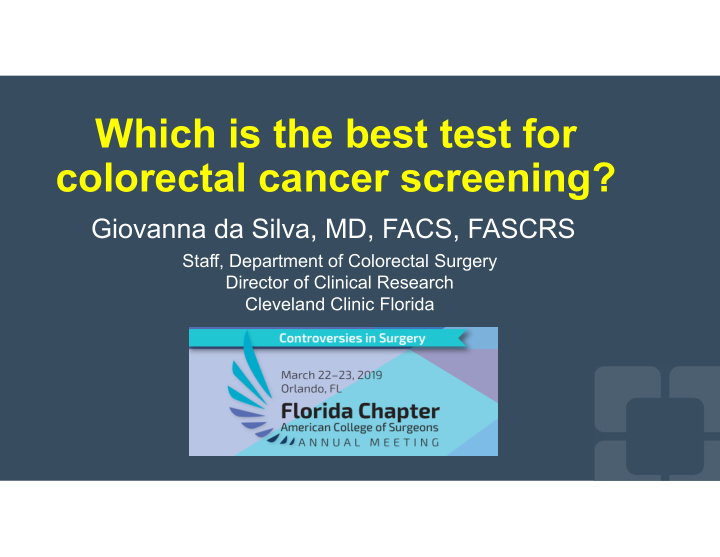



Which is the best test for colorectal cancer screening? Giovanna da Silva, MD, FACS, FASCRS Staff, Department of Colorectal Surgery Director of Clinical Research Cleveland Clinic Florida
Disclosures • None
Colorectal Cancer (CRC) Siegeel. R et al, Ca Cancer J CLIN 2017
National Goal Percentage of U.S. Adults Age 50-75 years Up-to-Date with CRC Screening, Behavioral Risk Factor Surveillance System 1/3 Americans > 50 years of age do not follow recommended screening American Cancer Society
Colon cancer screening guidelines US Preventive Services Task Force Guidelines (USPSTF) American Cancer Society ( ACS) TESTS USPSTF ACS Frequency 2016 2018 Every Stool-Based Tests gFOBT (HS) Yes Yes 1 y FIT Yes Yes 1 y FIT DNA Yes Yes 3 y ? Direct Visualization Tests Colonoscopy Yes Yes 10 y CT Colonography Yes Yes 5 y Flex sig Yes Yes 5 y Flex sig with FIT Yes No Flex sig 10y FIT 1 y
Stool-Based Tests Cons Pros • Less sensitive for • Noninvasive advanced lesions and • Can be done at home cancer • No bowel prep • Frequency • No medical restrictions • Low compliance • Colonoscopy if • Lower cost abnormal test • Suitable for mass • Don’t prevent screening programs CRC/advanced lesions
Fecal Occult Blood Test (gFOBT) • Guaiac FOBT (gFOBT) - Guaiac resin + Hb + H2O2 -- Blue - Need to avoid certain foods and meds - 3 stool samples • RCT: reduces CRC death by 15-30% when done every 1-2 years • 1-time sensitivity for CRC: 13-50% • High-sensitivity gFOBT: Hemoccult SENSA Shaukat A, NEJM 2013 Mandel jS, NEJM 2000
Fecal Immunochemical Test ( FIT) Antibody detects human Hb • - No need of dietary restriction - Single sample - Better sensitivity and specificity than gFOBT • Different cutoff values available in the US • Recommended every year • Meta-analysis - 1-time cancer detection: 50-79%; overall accuracy: 95% - Better patient compliance than gFOBT Mousavinezhad M et al, MJIRI, 2016 Lee J K et al. Ann Int Med, 2014
Polyp-Cancer Pathway Calderwood AH
FIT-DNA Cologuard • Combination of FIT and markers for abnormal DNA • Detect high-risk lesions: adenoma ≥10 mm, sessile serrated polyp, villous or tubulovillous adenoma, adenoma with high grade dysplasia • 1-time sensitivity for CRC: 92% • Cost $ 500 vs. $ 20 (FIT) • Recommended every 3 years
Stool-Based tests CRC detection Sensitivity Specificity FOBT Hemoccult SENSA 62-79% 87-96% FIT Light (10μg Hb/g) 79-88% 91-93% FIT Chek (20μg Hb/g) 73-75% 91-95% FIT DNA 92% 84% USPSTF JAMA 2016
FIT-DNA vs. FIT Sensitivity n=9989 Cancer Advanced (n=65) Neoplasia (n=757) FIT-DNA 92.3% 42.4% FIT 73.8% 23.8% Imperiale TF et al, NEJM, 2014
FIT DNA vs. FIT Specificity n=9989 Negative for Entirely non advanced negative lesions colonoscopy FIT-DNA 86.6% 89.9% FIT 94.9% 96.4% FIT DNA: more false positives extra colonoscopy Imperiale TF et al, NEJM, 2014
Direct Visualization Tests Colonoscopy/Flexible sigmoidoscopy • High sensitivity for cancer and all pre cancerous lesions • Single-session diagnosis and treatment • Longer interval between examination
Direct visualization Tests Colonoscopy/Flexible sigmoidoscopy • Need of bowel prep • Need of sedation • Operator dependent • Costs Lower for flex sig • Risks - Perforation – 4/10.000 - Bleeding 8/10.000 Lin JS, USPSTF. 2016
Colonoscopy& Flex sig Meta-analysis & Systematic review • Flexible sigmoidoscopy (4 RCT) - Reduction in CRC incidence and/or mortality of 29-76%- less for distal CRC • Colonoscopy (10 obs studies) - Reduction in CRC incidence and mortality of 80% distal colon and 40-60% in the proximal colon Brenner H et al, BMJ 2014 Rex DK, Am J Gastroenterology, 2014
Robertson DJ
• 9167 patients with adenoma removed at baseline/no cancer • Median FU 47.2 months • 58 (0.6%) diagnosed with cancer Gut.2014
Colonoscopy Quality benchmarks • Adenoma detection rate: 25% • Cecal Intubation: 90% • Photo documentation • Withdrawal time: 6-9 min • Bowel preparation: 85% adequate - Inadequate bowel prep should be repeated within 1 year Anderson JC, Clinical And translational Gastroenterology, 2015
CT Colonography • Patients who refuses, can’t undergo or had incomplete c-scope • Sensitivity 67-94% for adenomas > 1 cm • 40-70% incidentalomas- potential harm • Radiation exposure • Recommended every 5 years • Insurance coverage might be challenging
CT Colonography vs.Colonoscopy Meta-analysis • 3163 Colonoscopy (OC) • 3120 CT colonography (CTC) - 246 (7.9%) referred to OC (polyp > 6 mm) • No statistical difference - Cancer CTC 0.4% vs. OC 0.1% - Advanced lesions: CTC 3.2% vs. OC 3.4% • OC: 0.2% colonic perforation Kim DH et al NEJM 2007
Colorectal cancer screening Which is the best test?
Choice can improve adherence RCT n=997 Inadomi JA et al Arch Intern Med. 2012
U.S Multi-Society Task Force Colorectal Cancer ( MSTF) Ranking • Tier1 - Colonoscopy every 10 years - Annual fecal immunochemical test • Tier 2 - CT colonography every 5 years - FIT DNA every 3 years - Flexible sigmoidoscopy every 5-10 years • Tier 2 - Capsule colonoscopy every 5 years
Colorectal cancer screening Which is the best test? “The best colorectal cancer screening test is the one that gets done” Richard Wender , MD
Thank you!
Recommend
More recommend